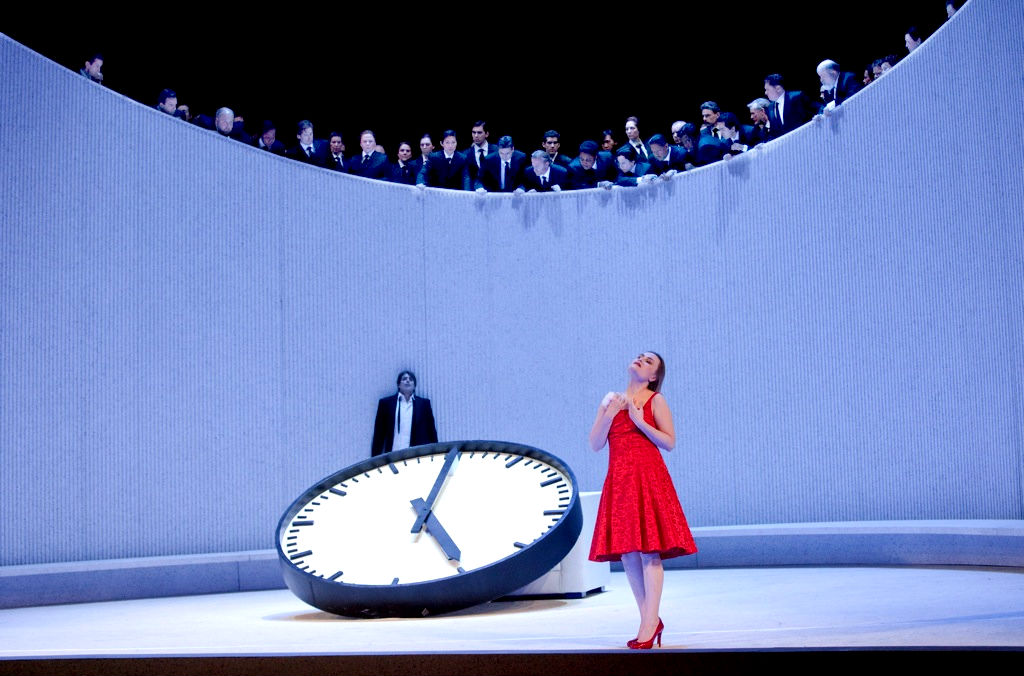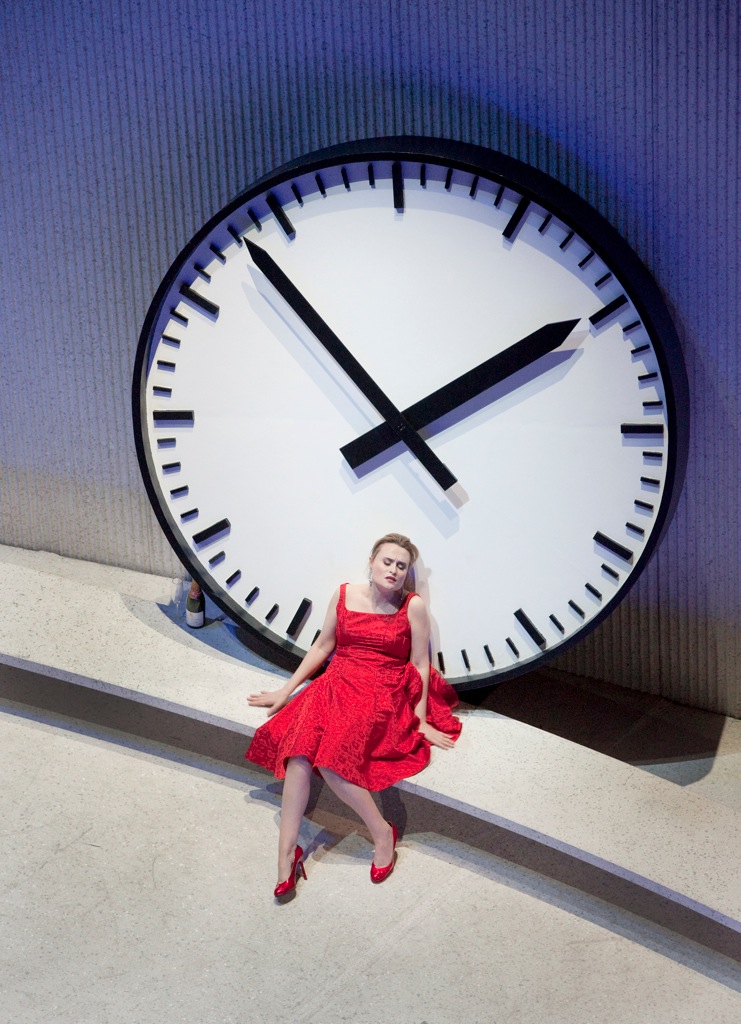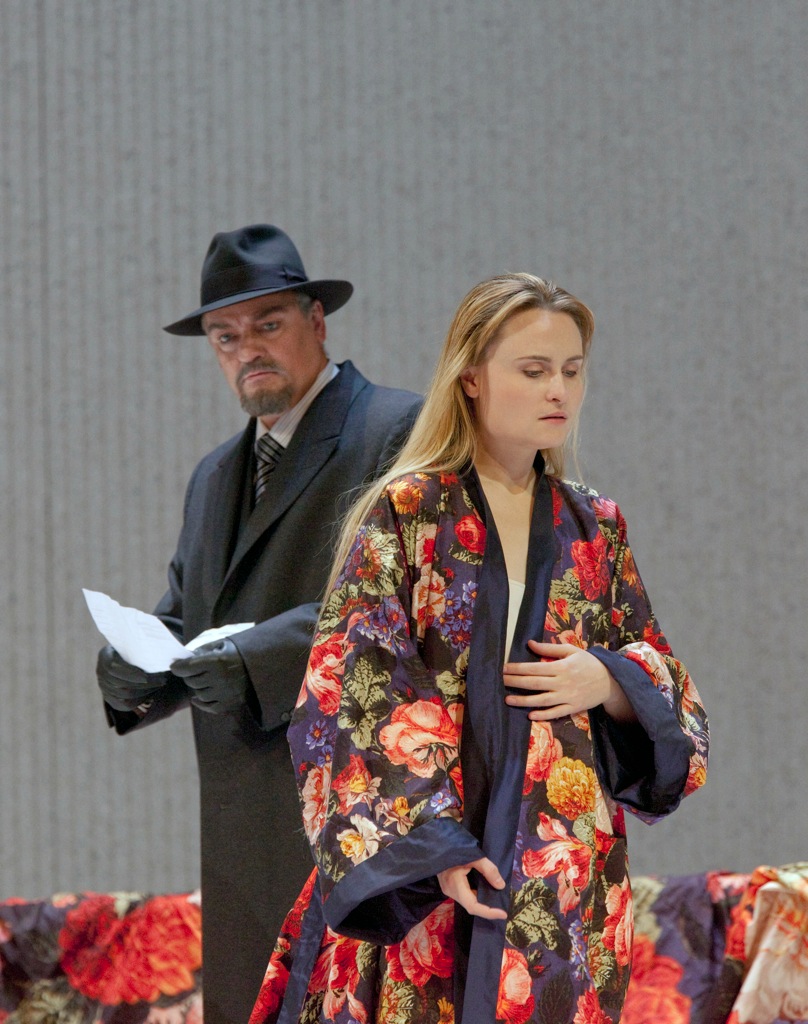By James Jorden
New Year’s Eve may have marked a significant turning point for the Gelb administration at the Metropolitan Opera. The replacement of the “beloved” Franco Zeffirelli Traviata extravaganza with a lean, mean non-literal staging has garnered rapturous reviews and strongly positive audience reactions. The single reported boo for director Willy Decker’s production team (someplace over house left in Orchestra) was, from where I was sitting, drowned out by applause and moderate cheering- though, to be perfectly accurate, there weren’t many shouts of “bravo.”
The point, though, is that the sky hasn’t fallen. Big Bad Regie hasn’t chased the audiences away from the Met. Remaining performances of the run, including tonight’s, are heavily sold, and rumor has it that the production will be revived in the next two seasons. So, what went right? Why is Traviata the triumph that Tosca or (thus far) the new Ring is not?
It’s not just that Willy Decker is a talented, experienced director: Luc Bondy is, too, and the Tosca is equal parts bland and messy. And it’s not just that the Met devoted a lot of time and money to Traviata, because the new Lepage Ring will be both fabulously expensive and gigantically labor-intensive, and, based on what I’ve seen of Das Rheingold, the project may well amount to to old wine in high-tech bottles.
The answer may not be so mysterious after all. Decker’s vision of Traviata, like most great productions, combines emotional truth with intellectual rigor—or, rather, there is a synergy between these two qualities that illuminates the entire work.
The first and most basic idea informing Decker’s Traviata is that of dramatic genre. The performance history of the opera takes place almost entirely along the continuum from romanticism to something approaching naturalism, with most productions (the outgoing Zeffirelli, for example) somewhere in the middle of that scale, a heightened and softened form of realism. Decker instead treats it as a symbolist work, with the dream logic of a Maeterlinck play, or, for that matter, of a Wagner music drama.
There’s a sound basis for this choice: La traviata can be understood not so much as a realistic slice of life but (in this later stage of evolution from the Dumas La Dame aux Camélias) as a myth, as much a thing of archetypes as Der Ring des Nibelungen. As Julian Budden points out in The Operas of Verdi,
The plot of Dumas’s novel is essentially a myth, no less the universal for being modern… nor is it any less mythical for having had its roots in personal experience…. In its progress from novel to play and then to opera, we can watch fact being transformed into a great work of art.
The building blocks of myth are symbols, and in this Traviata Decker accomplishes the feat of elevating visual details to symbols without ever losing the connection to reality. Thus Traviata takes place not in a drawing room but the drawing room, an abstraction of the bourgeois “public space” within a private dwelling. As a public space, it is a place to see and to be seen, and so, on the model of a baroque theater or an arena, the space is divided into a lower area for action and an upper “gallery” for observation.

Sometimes the balcony is really a balcony, as when Flora’s guests observe the improvised “gypsy” ballet with a Alfredo as unwilling danseur noble, and sometimes the upper level is used as a sort of Shakespearian “inner above,” allowing the Grenvil/Death figure to eavesdrop unseen on Violetta’s confrontation with Germont.
With the upper level established as both a literal and a symbolic space, Alfredo’s denunciation can be viewed as both a real action taking place in real ballroom, with party guests observing in horror, and a symbolic performance with the chorus joining us in the Met auditorium as audience. (That sense of community is reinforced by the shape of the set, which echoes the horseshoe architecture of the Met’s balconies.)
The symbolic object that has come in for the most criticism in this production is the enormous clock that leans against a stage left wall through most of the first two acts, then is dragged center stage to double as a wheel of fortune, and finally is spirited out the stage right door just before Alfredo’s return in the final act. If the only function of the clock were to indicate a countdown to Violetta’s doom, it would be a ham-handed symbol indeed. But again, Decker is working on more than so obvious a single level.

To begin with, the focus on the passage of time is not imposed on the work by the director; rather, he is underlining allusions already in the text. The very first lines of the libretto are “Dell’invito trascorsa è già l’ora / Voi tardaste. Giocammo da Flora./ E giocando quell’ore volar.” (“The hour you were invited for is long past / You are late. We were playing cards at Flora’s / and gambling makes time fly.”) The revelers conclude their participation in the act less than half an hour later with a chorus beginning “Si ridesta in ciel l’aurora, /E n’è forza di partir;” (“Dawn is rising in the sky, prompting us to depart.”) Further references to time pepper the libretto, most notably Dr. Grenvil’s chilling announcement, “La tisi non le accorda che poche ore.” (“The disease gives her only a few hours.”)
The giant clock, then, is not meant to bludgeon us with the message “time is running out!” but rather to emphasize that, conscious of the brevity of her life, Violetta is determined to wring experience from every moment—though, ironically, by throwing herself so passionately into pleasure, she is further shortening her life. Even her idyll with Alfredo can only pause the progress of time temporarily, so when she removes the drape that has partially concealed the clock’s face during the second act, we get a sense of inevitability: her happiness was sure to end sooner or later.
Further strengths of Decker’s symbolic vocabulary are economy and consistency. The camellia Violetta hands Alfredo is an obvious enough symbol of love, and it’s a tiny but brilliant touch to make the last act “immagine” not a miniature portrait but another bloom. But Decker reinforces the power of the symbol by including camellias in the floral print slipcovers that adorn the act two country house, the matching dressing gowns Violetta and Alfredo wear, and, most significantly, in the oversized wallpaper decorating the cyclorama for this act. In what is to my mind the production’s visual pièce de résistance, that wallpaper gradually fades to a harsh black and white as Violetta’s dream of love dies, then returns with Alfredo for the finale ultimo, regaining and even surpassing its original color to finish the opera in a surrealistic blaze of red.

There are many other symbols I haven’t even touched on: Grenvil-as-death, the rampaging playboy clone chorus, the towering doors that disappear into the wall as they close inexorably—all testimony to the inventive intelligence of Decker’s work. Every image onstage has its symbolic value, and every moment of the production can be perceived clearly on both symbolic and real levels. And yet, for all that, the action is never coldly intellectual; in fact, this is one of the most deeply emotional Traviatas of my experience.
So what is the formula for Decker’s success? If I could understand that completely, not only would I be directing at Bayreuth, I might even go after Peter Gelb’s job. In the meantime, what the Met needs to do is to hire more Willy Deckers.
Photos: Ken Howard/Metropolitan Opera.
Tags: franco zeffirelli, peter gelb, regie, symbols, the met, willy decker